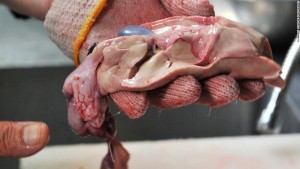Five men have been poisoned in Japan after allegedly asking a restaurant to serve them banned parts of the world’s most toxic fish.
 The men were having dinner on Friday night in the western city of Wakayama when they ate puffer fish liver, which prompted vomiting and breathing difficulties early the next morning.
The men were having dinner on Friday night in the western city of Wakayama when they ate puffer fish liver, which prompted vomiting and breathing difficulties early the next morning.
Puffer fish – also called blowfish or fugu in Japanese – are the world’s most toxic group of fish and their livers, ovaries and skin contain tetrodotoxin, 100 times more lethal than cyanide.
Yet eating the fish’s flesh is a tradition in Japan, where wealthy diners play the Russian roulette of the restaurant world by dining on sashimi slivers so thin they are almost transparent.
According to a city health official, the men asked to eat a banned, toxic part of the fish – which the most foolhardy fugu aficionados are said to enjoy for the tingling it produces on the lips.
The tingling is only the first symptom of tetrodotoxin poisoning, and is seen as part of the thrill for lovers of the fish.
But if the toxin is served in any significant quantity it then paralyses the muscles, suffocating victims as it reaches their chests and diaphragms while they are still conscious.
The health official said the men were in their 40s and 50s and the restaurant was shut down for five days from yesterday amid an investigation.

